Last Updated on December 29, 2021 at 5:30 pm
In ‘The Intelligent Investor’ Benjamin Graham recommended a 50% stocks and 50% bonds allocation for the typical retail investor who cannot spare the time for deeper investigation into security selection and tactical asset allocation. We find out how this strategy has fared for Indian markets.
Most financial advisors (influenced by commissions) and most DIY investors are likely to term this asset allocation as conservative and are expected to bat for a much higher allocation to stocks for “long-term goals”. We have just seen how that well that turned out: 15-year Nifty SIP returns crash to 8% (51% reduction since 2014) and Ten-year SIP Return of Most Equity Mfs is now less than 10%
SEBI registered investment advisor Swapnil Kendhe explains why this 50-50 asset allocation recommended by Graham is prudent for pretty much all investors: Are you a conservative investor? Here is how you can grow your money smartly
Join 32,000+ readers and get free money management solutions delivered to your inbox! Subscribe to get posts via email! (Link takes you to our email sign-up form)
🔥Want to create a complete financial plan? Learn goal-based investing? Exclusive access to our DIY tools? Increase your income with your skills? Use this link to enjoy massive discounts on our robo-advisory tool & courses! 🔥
Using the machinery explained in – This is how buying US stocks will affect your portfolio – we compare the performance of a 50% Sensex + 50% long-term gilts (I-BEX gilt index) with a 100% Sensex portfolio over 10-year investment durations.
Before we proceed readers must appreciate some important considerations. (1) When we mix stocks and bonds to create a portfolio, there is no way an ideal allocation can be determined. You can only draw one straight line between two data points.
If you mix white paint with red paint, you get continuous change from red to white going through different shades of pink. There is no way to tell which shade of pink is better. It is up to individual choices. So there is little point in comparing returns of a 50% stock portfolio with 70% stock portfolio.
With three asset classes – stocks, bonds and gold – it makes sense to hunt for a “sweet spot”. Whether we find it or not is another matter. More on this later.
With 50% stocks and 50% bonds, the portfolio has an appealing balance. It would suffer less during a market crash and long-term bonds could possibly gain and bolster the portfolio
(2) We are looking at a generic long-term portfolio with unchanged 50% stocks 50% bonds portfolio. Realistic individual portfolios will have a deadline (ideally a well-defined goal) and the asset allocation should be tapered down to manage risk. We shall not consider this aspect here. The lectures on goal-based portfolio management are dedicated to this singular cause.
(3) Data is only available from Sep 1996 and the Indian markets are constantly changing. It would be better if investors evaluate the 50-50 portfolio absolutely and not relatively (ie. compare with 70% stock portfolio etc.)
(4) The bond portfolio mentioned in this article refers to a long-term gilt mutual fund which carries significant interest rate risk. Rebalancing is essential to handle this risk.
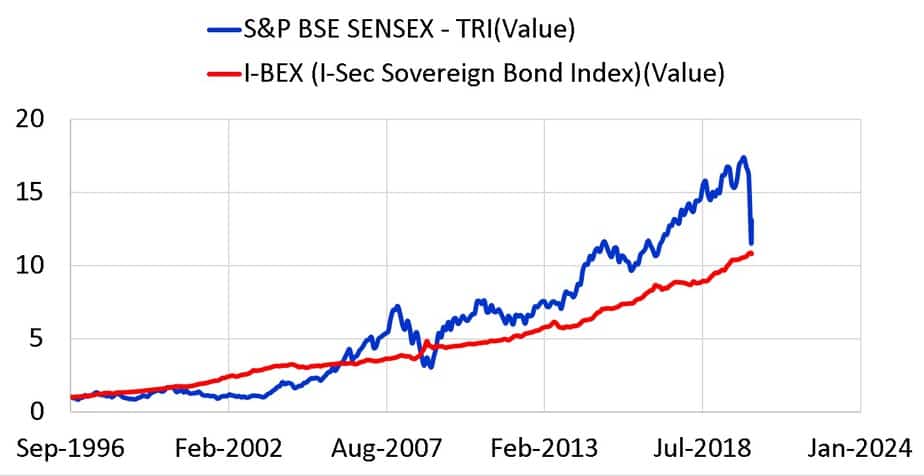
Instead of investing only in the Sensex (only the blue line) if we keep adding more and more of the red line, the volatility (for the above data set) will decrease. Returns will depend on timing luck. That is, it depends on the set of months over which the investment made.
Now consider a 10-year investment period ranging from Sep 1996 to Sep 2006 (1st run).
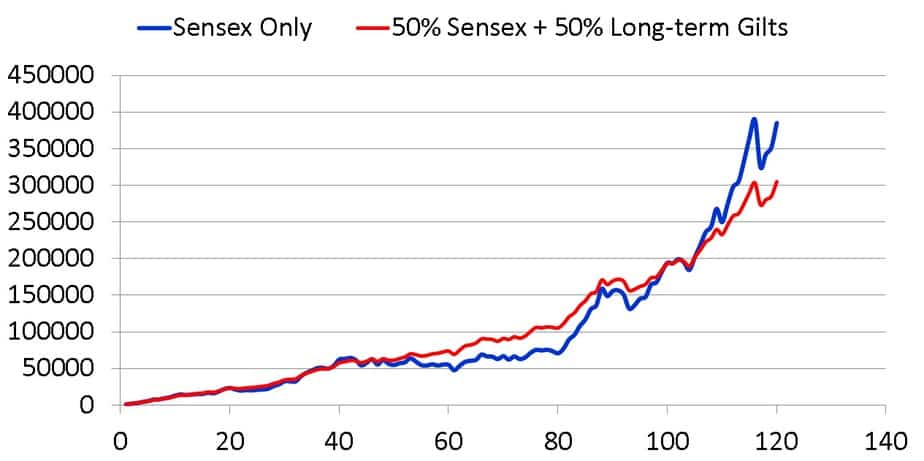
- XIRR 100% Sensex = 22.4% (1st run)
- XIRR 50:50 portfolio = 18% (1st run)
- Return difference: XIRR 100% Sensex – XIRR -50-50 = -4.4% (1st run)
- Beta = 84% (16% lower volatility than 100% Sensex portfolio)
We can simulate 165 10-year runs from Sep 1996 to April 2020. The return difference and beta of each run are plotted below. The beta is fairly constant and therefore an average makes sense: 83%
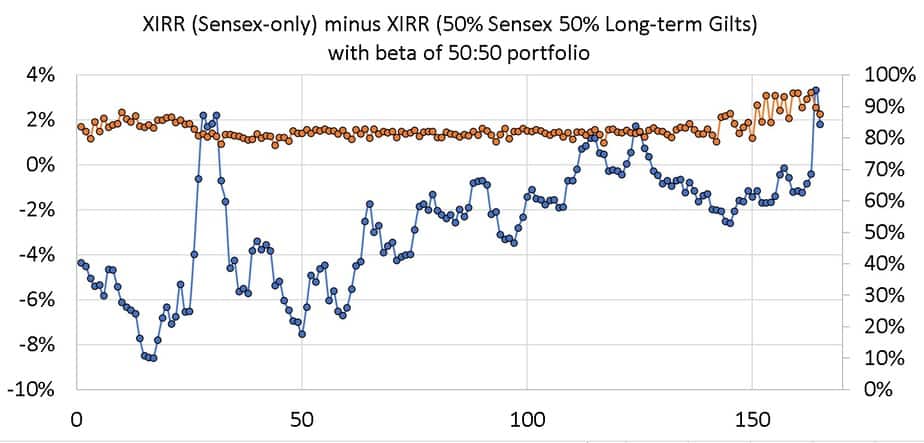
The efficiency of the 50-50 portfolio is seen when the Sensex is plotted alongside the return difference. Every time the Sense fell, the 50-50 portfolio Did better.
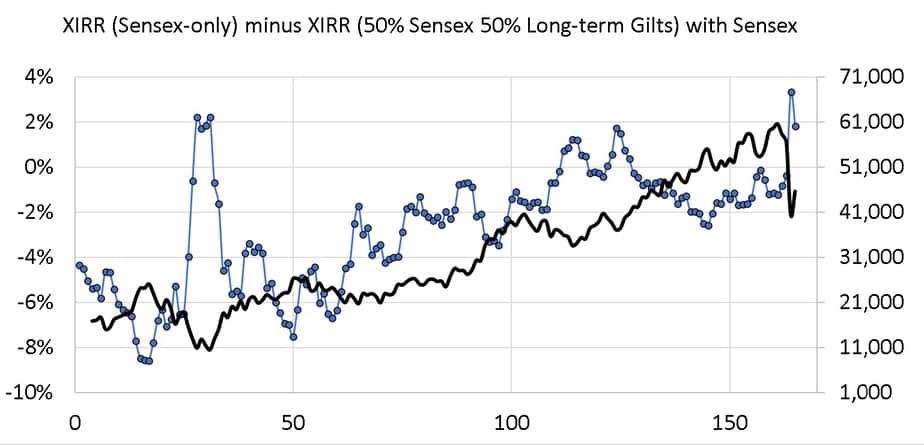
These are the absolute XIRR values.
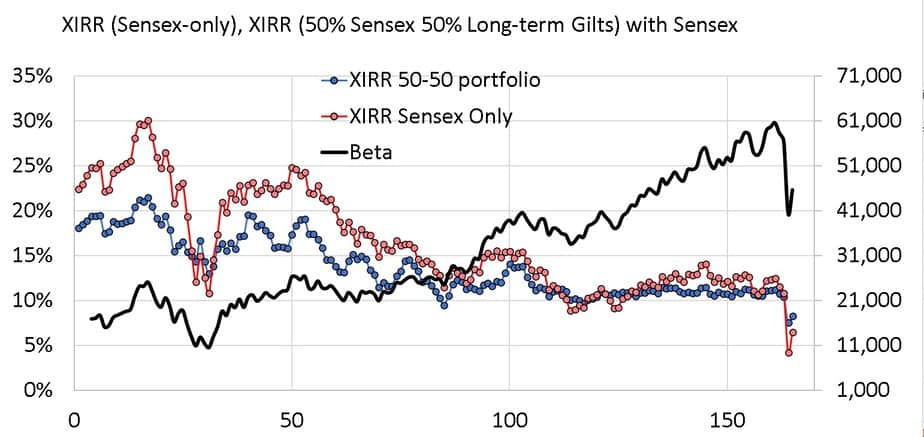
The 50-50 portfolio has given less than 10% returns only four times (out of 165 runs) in the past. While this means nothing for the future, the point of this article is, holding “only” 50% equity does not make you a conservative investor! In fact, it is quite prudent and Ben Graham’s recommendation works like a charm.
Of course, if we increase (or decrease) equity exposure from 50% we can narrow (or widen) the gap between the blue and pink dots in the above picture. With two asset classes, it becomes a matter of personal choice.
Since no can afford the investment necessary to beat inflation with a 100% fixed income portfolio, equity is necessary. The above results show that 50% of equity is good enough to strike a reasonable balance between what one can invest and the risk one can bear. HIgher equity allocations are not necessary.

Use our Robo-advisory Tool to create a complete financial plan! ⇐More than 3,000 investors and advisors use this! Use the discount code: robo25 for a 20% discount. Plan your retirement (early, normal, before, and after), as well as non-recurring financial goals (such as child education) and recurring financial goals (like holidays and appliance purchases). The tool would help anyone aged 18 to 80 plan for their retirement, as well as six other non-recurring financial goals and four recurring financial goals, with a detailed cash flow summary.
🔥You can also avail massive discounts on our courses and the freefincal investor circle! 🔥& join our community of 8000+ users!
Track your mutual funds and stock investments with this Google Sheet!
We also publish monthly equity mutual funds, debt and hybrid mutual funds, index funds, and ETF screeners, as well as momentum and low-volatility stock screeners.
You can follow our articles on Google News

We have over 1,000 videos on YouTube!

Join our WhatsApp Channel

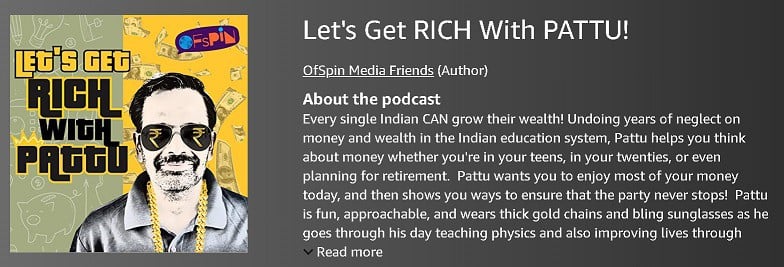

- Do you have a comment about the above article? Reach out to us on Twitter: @freefincal or @pattufreefincal
- Have a question? Subscribe to our newsletter using the form below.
- Hit 'reply' to any email from us! We do not offer personalised investment advice. We can write a detailed article without mentioning your name if you have a generic question.
Join 32,000+ readers and get free money management solutions delivered to your inbox! Subscribe to get posts via email! (Link takes you to our email sign-up form)
About The Author
 Dr M. Pattabiraman (PhD) is the founder, managing editor and primary author of freefincal. He is an associate professor at the Indian Institute of Technology, Madras. He has over 13 years of experience publishing news analysis, research and financial product development. Connect with him via Twitter(X), LinkedIn, or YouTube. Pattabiraman has co-authored three print books: (1) You can be rich too with goal-based investing (CNBC TV18) for DIY investors. (2) Gamechanger for young earners. (3) Chinchu Gets a Superpower! for kids. He has also written seven other free e-books on various money management topics. He is a patron and co-founder of “Fee-only India,” an organisation promoting unbiased, commission-free, AUM-independent investment advice.
Dr M. Pattabiraman (PhD) is the founder, managing editor and primary author of freefincal. He is an associate professor at the Indian Institute of Technology, Madras. He has over 13 years of experience publishing news analysis, research and financial product development. Connect with him via Twitter(X), LinkedIn, or YouTube. Pattabiraman has co-authored three print books: (1) You can be rich too with goal-based investing (CNBC TV18) for DIY investors. (2) Gamechanger for young earners. (3) Chinchu Gets a Superpower! for kids. He has also written seven other free e-books on various money management topics. He is a patron and co-founder of “Fee-only India,” an organisation promoting unbiased, commission-free, AUM-independent investment advice.Our flagship course! Learn to manage your portfolio like a pro to achieve your goals regardless of market conditions! ⇐ More than 3,500 investors and advisors are part of our exclusive community! Get clarity on how to plan for your goals and achieve the necessary corpus no matter the market condition!! Watch the first lecture for free! One-time payment! No recurring fees! Life-long access to videos! Reduce fear, uncertainty and doubt while investing! Learn how to plan for your goals before and after retirement with confidence.
Increase your income by getting people to pay for your skills! ⇐ More than 800 salaried employees, entrepreneurs and financial advisors are part of our exclusive community! Learn how to get people to pay for your skills! Whether you are a professional or small business owner seeking more clients through online visibility, or a salaried individual looking for a side income or passive income, we will show you how to achieve this by showcasing your skills and building a community that trusts and pays you. (watch 1st lecture for free). One-time payment! No recurring fees! Life-long access to videos!
Our book for kids: “Chinchu Gets a Superpower!” is now available!


Must-read book even for adults! This is something that every parent should teach their kids right from their young age. The importance of money management and decision making based on their wants and needs. Very nicely written in simple terms. - Arun.Buy the book: Chinchu gets a superpower for your child!
How to profit from content writing: Our new ebook is for those interested in getting a side income via content writing. It is available at a 50% discount for Rs. 500 only!
Do you want to check if the market is overvalued or undervalued? Use our market valuation tool (it will work with any index!), or get the Tactical Buy/Sell timing tool!
We publish monthly mutual fund screeners and momentum, low-volatility stock screeners.
About freefincal & its content policy. Freefincal is a News Media organisation dedicated to providing original analysis, reports, reviews and insights on mutual funds, stocks, investing, retirement and personal finance developments. We do so without conflict of interest and bias. Follow us on Google News. Freefincal serves more than three million readers a year (5 million page views) with articles based only on factual information and detailed analysis by its authors. All statements made will be verified with credible and knowledgeable sources before publication. Freefincal does not publish paid articles, promotions, PR, satire or opinions without data. All opinions will be inferences backed by verifiable, reproducible evidence/data. Contact Information: To get in touch, please use our contact form. (Sponsored posts or paid collaborations will not be entertained.)
Connect with us on social media
- Twitter @freefincal
- Subscribe to our YouTube Videos
- Posts feed via Feedburner.
Our publications
You Can Be Rich Too with Goal-Based Investing
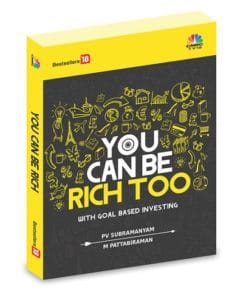 Published by CNBC TV18, this book is designed to help you ask the right questions and find the correct answers. Additionally, it comes with nine online calculators, allowing you to create custom solutions tailored to your lifestyle. Get it now.
Published by CNBC TV18, this book is designed to help you ask the right questions and find the correct answers. Additionally, it comes with nine online calculators, allowing you to create custom solutions tailored to your lifestyle. Get it now.Gamechanger: Forget Startups, Join Corporate & Still Live the Rich Life You Want
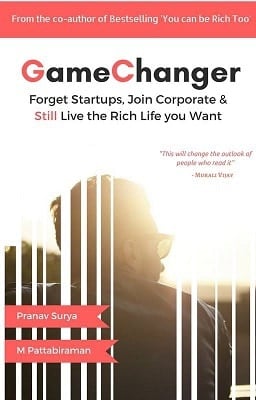 This book is designed for young earners to get their basics right from the start! It will also help you travel to exotic places at a low cost! Get it or gift it to a young earner.
This book is designed for young earners to get their basics right from the start! It will also help you travel to exotic places at a low cost! Get it or gift it to a young earner.Your Ultimate Guide to Travel
 This is an in-depth exploration of vacation planning, including finding affordable flights, budget accommodations, and practical travel tips. It also examines the benefits of travelling slowly, both financially and psychologically, with links to relevant web pages and guidance at every step. Get the PDF for Rs 300 (instant download)
This is an in-depth exploration of vacation planning, including finding affordable flights, budget accommodations, and practical travel tips. It also examines the benefits of travelling slowly, both financially and psychologically, with links to relevant web pages and guidance at every step. Get the PDF for Rs 300 (instant download)